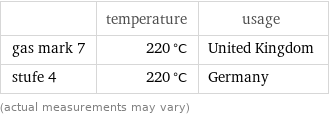Input interpretation

1, 10-phenanthroline hydrochloride | melting point
Result

224.5 °C (degrees Celsius)
Unit conversions

497.7 K (kelvins)

436.1 °F (degrees Fahrenheit)

895.8 °R (degrees Rankine)

179.6 °Ré (degrees Réaumur)

125.4 °Rø (degrees Rømer)
Comparisons as temperature

8.278 °C below autoignition temperature of book paper in Ray Bradbury's famous novel (451 °F)

21.5 °C below to 6.5 °C above autoignition temperature of paper (218 to 246 °C)

97.5 °C above hottest temperature of a Concorde nose tip (127 °C)
Corresponding quantities

Thermodynamic energy E from E = kT: | 43 meV (millielectronvolts)

Blackbody energy flux Φ from Φ = σT^4: | 3478 W/m^2 (watts per square meter)

Approximate luminous exitance from a planar blackbody radiator perpendicular to its surface: | 1.2×10^-9 lx (lux)
Nearest corresponding gas marks

| temperature | usage gas mark 7 | 220 °C | United Kingdom stufe 4 | 220 °C | Germany (actual measurements may vary)